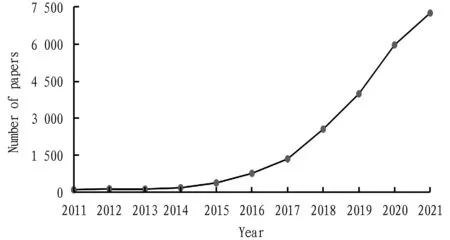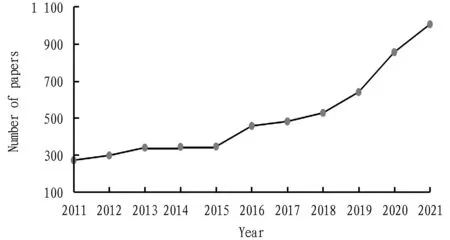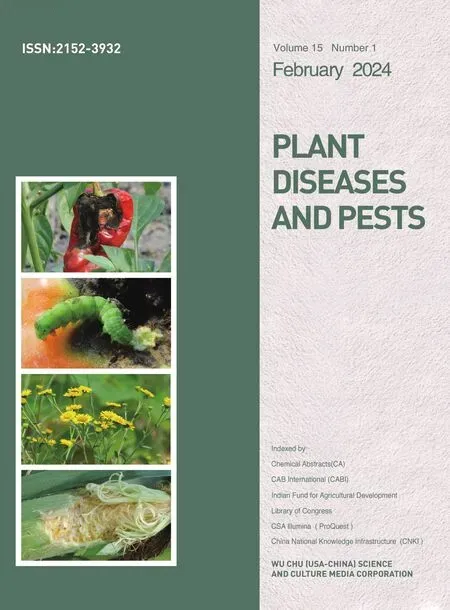Research on Blended Teaching Mode: A Case Study of Floristry
Xiaoru CHEN
Huizhou Engineering Vocational College, Huizhou 516023, China
Abstract In order to better carry out research on education and teaching, the author consulted relevant literature on blended teaching mode from 2011-2021 through CNKI, Web of Science and other websites, summarized and analyzed the research status of blended teaching mode, in order to lay a good foundation for studying blended teaching mode in course teaching.
Key words Blended teaching; Teaching mode; Research review
1 Introduction
Teaching mode refers to the relatively stable, interrelated and operational teaching links set for the completion of teaching objectives. Blended teaching is a new teaching method that combines "online" and "offline". Online learning mainly refers to the teaching activities of teachers and learning activities of students based on teaching platforms (such as MOOCs, Chaoxing learning platform, Rain class, smart vocational education platform, Moso Teach,etc.). Offline learning refers to a series of discussions and interactions between teachers and students on the learning tasks of the course. Blended teaching mode refers to the teaching activity program that uses information resources to integrate the advantages of online and offline into different examples, so as to realize autonomous, personalized and creative teaching and achieve the purpose of improving quality and efficiency.
Floristry is a basic and compulsory course for students majoring in landscape technology. This course is offered in secondary vocational schools, higher vocational colleges and full-time undergraduate education, including the main learning content of types and identification of flowers, flower propagation technology, flower cultivation management technology and application of flowers, production technology of various flowers,etc.The course aims to guide students to pay attention to the development of China’s flower industry and industry, and strive to promote the progress of flower scientific research. On the basis of understanding the types of flowers, students can undertake the production, cultivation, maintenance and management of flowers in flower enterprises and horticultural landscape enterprises, provide services for flower production and maintenance of enterprises as well as the beautification of flower beds and flower borders, thereby achieving the goal of enterprises. This course is generally opened in the first semester of the first grade, and plays a very important role in the process of cultivating the quality of students majoring in landscape technology.
2 Research on blended teaching
In order to understand the research status of blended teaching, I retrieved the literature in CNKI database. With "subject" as the retrieval item, "blended teaching" as the search word, and "precise" as the matching method, a total of 22 646 papers were obtained from January 1, 2011 to December 31, 2021 (Fig.1).

Fig.1 Number of published papers on "blended teaching" in China from 2011 to 2021
I searched the Web of Science database, with the theme of "blended teaching" and the literature types limited to "thesis", "review thesis" and "academic dissertation". A total of 5 573 papers were obtained from January 1, 2011 to December 31, 2021 (Fig.2).

Fig.2 Number of published papers on "blended teaching" abroad from 2011 to 2021
As shown in Figs.1-2, the number of research papers on blended teaching was increasing year by year both at home and abroad, and blended teaching had gradually become a hot spot. Particularly, scholars in China have paid more and more attention to the research on blended teaching in recent years.
2.1 Concept of blended teachingElaine and Kevin were the first to explicitly introduce the concept of blended teaching. Based on the theories of educational communication, humanistic learning, situated cognition, constructivist learning, blending virtuality and reality, blended teaching advocates the effective combination of different learning time, learning environment, learning resources and learning styles, so as to complement the advantages of traditional classroom and modern network, and optimize the learning effect to the maximum extent[1]. Feng Huishanetal.[2]suggested that blended teaching refers to a teaching mode that combines the advantages of traditional classroom teaching and online teaching with teachers as the leading and students as the main body in the teaching process to achieve the best teaching effect. Li Jiahou[3]pointed out that the essence of blended learning is to optimize all elements of teaching based on information technology, so as to achieve educational goals.
Through the review of the concept of blended teaching by the above scholars at home and abroad, it can be seen that most scholars hold that blended teaching is a mixture of online teaching and traditional teaching, aiming to improve the teaching effect through the complementary advantages of the two. However, different research perspectives lead to different definitions of the concept of blended teaching.
2.2 Blended teaching modeThe research of blended teaching mode is mostly combined with the construction and design of online classroom platforms, such as Chaoxing learning platform, Moodle, SPOC, Wechat and so on. Lu Lifangetal.[4]adopted a teaching mode composed of three parts: pre-preparation for blended teaching, blended teaching activity design and blended teaching evaluation design, to conduct empirical research. In theApplicationofOnlineandOfflineMixedTeachingBasedonChaoxingLearningintheTeachingofMedicalImagingPrinciples, Yue Ruomeng[5]proposed the implementation mode of blended teaching, which consisted of pre-class exploration, in-class guidance and after-class expansion. First, pre-class exploration is the preparation stage. Teachers need to publish teaching resources and put forward requirements according to teaching objectives; students receive tasks for learning and test online. The teaching difficulties are determined through test results and feedback. The second is in-class guidance, including three stages: case introduction; task definition, knowledge allocation; principle teaching, conclusion &evaluation, and expansion of thinking. Finally, after-class expansion is performed. Teachers make full use of platform data analysis and supplement the teaching content by combining with students’ interests and the latest research results, so as to achieve personalized teaching[5].
In the blended teaching mode, there are many teaching methods, such as flip method, task-driven method, independent learning method, interactive method, team cooperation method, situational teaching method and case analysis method. For example, in theDesignofNewBlendedLearningModelBasedonFlippedClassroom, Zhang Qiliangetal.[6]implemented blended teaching through flipped classroom teaching, transformed the roles of teachers and students and made students in the center of the whole learning process, making students become the subject of learning, and teachers become the facilitator and inductor of learning. Such flipped classroom design can not only increase students’ learning freedom, but also play a good supervisory role in learning, making up for the shortcomings of traditional classroom teaching to a certain extent. Zhang Xiaetal.[7]adopted the task-driven teaching method under the rotating team leader responsibility system to carry out practice in the blended teaching of "microbiology experiment". Through the three links of revising the preview report before class, presenting the topic briefly and succinctly in class, and summarizing and evaluating after class, they encouraged students to complete the task, which is of great help to the cultivation of students’ active learning ability, independent analysis ability and innovation ability,etc.This teaching method is worth promoting in courses with strong operability.
After literature review and research, it is found that most scholars adopt the three-stage blended teaching mode before class, in class and after class, which has become the mainstream segmented way for scholars to study blended teaching, and then carry out personalized detailed design according to the actual situation of teaching and different purposes of research. Appropriate teaching methods have important influence on the smooth implementation of blended teaching. Different studies have different teaching methods. The main teaching methods used in this study include task-driven method, flip method and independent learning method.
2.3 Application of blended teachingAt abroad, applied research on blended teaching involves social science, science and technology, life science, physical science and other fields, with the research interests of education research, computer science, psychology,etc.Education research is the top topic, with the number of papers as high as 1 834, followed by computer science with 895 papers. For example, Qin Li[8]adopted blended teaching method to carry out English picture book intensive reading class, which gave full play to the advantages of both traditional education and network education, thus promoting the teaching effect of English intensive reading course. InExploringHybridTeachingMethodsforHispanicAgriculturalWorkers, Uribeetal.[8]pointed out that blended teaching refers to the teaching of courses through traditional, face-to-face teaching and online teaching outside the classroom. Courses taught by blended teaching method are popular, and students have expressed interest in attending more courses offered in a mixed format. Compared with the test scores at the beginning of the course, the test scores after the implementation of blended teaching have been significantly improved[9].
In China, the applied research of blended teaching mainly includes chemistry, building science and engineering, trade economy and other professional fields. At present, the application of blended teaching can be roughly divided into basic courses and specialized courses. Specialized courses are mainly concentrated in disciplines with strong operability and high information technology, such as computer software and computer application, medicine, computer hardware technology and so on. Aiming at the disconnection between theory and practice in the comprehensive experimental teaching of TCM pharmaceutical major, Li Cunyuetal.[10]designed and practiced the teaching scheme in the comprehensive experimental teaching of TCM pharmaceutical major with the help of online and offline blended teaching mode. By re-positioning the role relationship between teachers and students, the teaching concepts and teaching processes were built by using information teaching platform, network teaching resources, production practice teaching base and other resources, to stimulate students’ spirit of learning, release the career potential of teaching assistants, and rationally allocate experimental teaching resources. Practice has shown that by breaking the restriction of "space-time-personnel", systematic training centering on problem guidance, theme design, practice execution and concluding report has promoted the double improvement of students’ theoretical learning and practical ability cultivation. However, through the literature search, it is found that there are relatively few blended teaching and research applications on the courses of landscape architecture, especially the courses of Floristry.
In a word, blended teaching research involves many fields, such as in-service training, school education, special education and adult education, both at home and abroad. However, it is mainly concentrated in the field of education, involving higher education, secondary education and vocational education. At the same time, scholars mainly focus on how to design blended teaching to bring better learning results, and discuss the reasons that affect the effect of blended teaching, so as to better design blended teaching, which provides certain reference value for the further research of subsequent scholars on blended teaching.
3 Influence of blended teaching on the course of Floristry
I searched on CNKI with the topic of "blended teaching" and found that there were 17 645 papers published from 2011-2021, including 16 900 academic journals and 745 master’s theses. At present, no papers have been found with "mixed teaching" and "floristry" as the subject search conditions. After analyzing and sorting out the relevant literature retrieved, it is found that most of them adopt the blended teaching mode of three stages: before class, in class and after class, and the teaching design according to specific courses is helpful to the improvement of teaching effect, but it is rarely applied in the field of landscape architecture. Under the background of information-based teaching reform, teachers should make use of the advantages of modern information technology to stimulate students’ interest and improve their participation in learning, change the teaching status of floristry, and further improve the core literacy of this discipline. Therefore, it is very necessary to study the Floristry course of landscape architecture major based on the blended teaching mode.

Table 1 Relevant data retrieved from CNKI in 2011-2021 paper
4 Review of existing research
Through the literature research at home and abroad, it can be seen that blended teaching research has been very rich, and has made great progress in theory and practice. In the research of blended teaching, first of all, the concept of blended teaching has undergone a clear evolution, but there is still no unified view. Secondly, the theoretical basis for implementing blended teaching is also diversified, including constructivism theory, project-based teaching theory, connectivist learning theory, pragmatic education theory, knowledge classification teaching theory,etc.Finally, most scholars conduct a comprehensive analysis of blended teaching by combining teaching methods, teaching platforms, teaching modes and education evaluation. Under the background of the "three education" reform, information-based teaching has received more and more attention. Based on Yue Ruomeng’s teaching mode of "pre-class exploration, in-class guidance and after-class expansion", the author intends to conduct a research on blended teaching to solve the problems existing in the teaching of the Floristry course, in order to effectively guide the teaching activities of Floristry in vocational colleges.
- 植物病虫害研究(英文版)的其它文章
- Comprehensive Prevention and Control Technology of Vegetable Diseases and Pests in Shandong Province
- Technical Points of Green Prevention and Control Technology of Major Diseases and Pests in Lixian Rhubarb (Rheum palmatum L.)
- Risk Analysis of Passalora sequoiae Invasion to China with Imported Coniferous Wood
- Determination of Ten Kinds of Alpha-2 Agonists Residues in Animal Derived Food by UHPLC-Triple Quadrupole/Composite Linear Ion Trap Mass Spectrometry
- Investigation and Analysis of Main Diseases of Landscape Plants in the Main Urban Area of Lu’an City
- Effects of Low Temperature Stress on Germination and Physiological Characteristics of Different Sweet Maize Varieties

